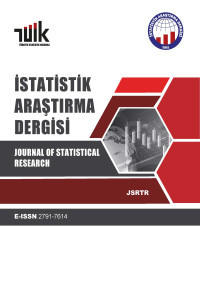ERP Yazılımı Kullanan ve Kullanmayan İşletmeler Arasındaki Yönetimsel ve Teknolojik Farklılıkların Tanımlayıcı Veri Madenciliği Yöntemleriyle İncelenmesi
Birliktelik kuralları analizi, ERP, Kümeleme, Veri madenciliği
Investigation of the Differences Between Companies With and Without Usage of ERP Software in Terms of Management and Technology via Descriptive Data Mining Methods
Association rules analysis, ERP, Clustering, Data mining,
___
- Su Y. F. & Yang C., 2009. A structural equation model for analyzing the impact of ERP on SCM, Expert Systems with Applications, 37(1),256-469.
- Yavasoglu B., 2011. Kurumsal Kaynak Planlama Sisteminin Etkinliği ve Uygulama, Yüksek Lisans Tezi, Gazi Üniversitesi Bilişim Enstitüsü Yönetim Bilişim Sistemleri.
- Cebeci, U., 2009. Fuzzy AHP-based decision support system for selecting ERP systems in textile industry by using balanced scorecard, Expert Systems with Applications, 36(5), 8900-8909.
- Saatcioglu, O. Y., 2007. What determines user satisfaction in ERP projects: Benefits, barriers or risks?, Proceedings of European and Mediterranean Conference on Information Systems 2007 (EMCIS2007) S. 24-26.
- Wu W. W., 2010. Segmenting and mining the ERP users' perceived benefits using the rough set approach, Expert Systems with Applications, doi:10.1016/j.eswa.
- Jacobs F. R., Weston F. C., 2007. Enterprise resource planning (ERP)-A briefl history, Journal of Operations Management, 25,357-363.
- Buonanno G., Faverio P., Pigni F., Ravarini A., 2009. Factors affecting ERP system adoption: A comparative analysis between SMEs and large companies, Journal of Enterprise Information, 18(4),384-426.
- Bozkir A. S., Gök B., Sezer E., 2008. İntemetin eğitimsel amaçlar için kullanımını etkileyen faktörlerin veri madenciliği ile tespiti, Bilimde Modern Yöntemler Sempozyumu, Eskişehir.
- Tang Z. H. and MacLennan J., 2005. Data Mining with SQL Server 2005, Wiley Publishing.
- Agrawal R., Imielinski T., Swami A., 1993. Mining association rules between sets of items in large databases. In Proceedings of the ACM SIGMOD international conference on management of data, 207-216.
- ISSN: 1303-6319
- Başlangıç: 2002
- Yayıncı: TÜİK
Ahmet Sinan TÜRKYILMAZ, H. Öztaş AYHAN
Gecikmesi Dağıtılmış Modellerde Yanlı Tahmin Ediciler
Regresyon Analizinde Gözlemlerin Aykırı Değer Haritası ile Sınıflandırılması
Yasemin KAYHAN ATILGAN, Süleyman GÜNAY
Esra PAMUKÇU, Cemil ÇOLAK, Sinan ÇALIK, Ülkü KARAMAN
Çokgen Alanlarda İki Değişkenli Birikimli Dağılım Fonksiyonunun Bulunması
Orhan KESEMEN, Fatma Zehra DOĞRU
Farlie-Gumbel-Morgenstern Kapula Ailesi, Bazı Genişletmeleri ve Bir Uygulama
Gamma, Weibull ve Log-Normal Dağılımlarının Doğru Seçim Olasılıklarına Göre Ayrıştırılması
Hayrinisa DEMİRCİ BİÇER, Cemal ATAKAN
Betül YAVAŞOĞLU, Ahmet Selman BOZKIR
İki Dağılış Parametresinin Eşitliği için Doğrusal Sıra İstatistiğine Dayalı Bir Test
